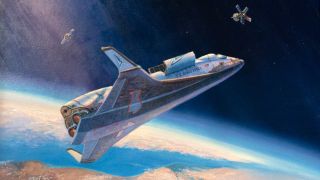
US Space Force's 1st official painting shows military space plane intercepting adversary satellite

United States Space Force's first official painting depicting a "futuristic" space plane intercepting a satellite. (Image credit: Space Force photo by John Ayre)
The United States Space Force has unveiled an official painting depicting a space plane intercepting an adversary satellite, perhaps illustrating a hint of what we can expect if orbital warfare is in our future.
Space Operations Command (SpOC), which provides orbital warfare and intelligence capabilities to the U.S. Space Force, unveiled the painting during a ceremony at Peterson Space Force Base in Colorado on Oct. 20. The artwork, titled "High Ground Intercept," was commissioned with artist Rick Herter and is SpOC's first official painting.
The painting depicts a roughly delta-shaped space plane, referred to as a "futuristic intercept vehicle," opening its payload bay doors as it moves into position to engage an adversary satellite that is itself targeting a friendly spacecraft. The space plane is reminiscent of past U.S. military space planes such as the X-20 Dyna-Soar or even today's highly mysterious X-37B, although SPoC stresses the painting's spacecraft is fictional.
Related: US Space Force creates 1st unit dedicated to targeting adversary satellites
"Because of the highly classified nature of many space operations, SpOC requested that Herter rely on historic space planes and his own imagination," SpOC historian Christopher Rumley said in a Space Force statement.
Painting a purely notional space plane wasn't easy, artist Herter said, because he had very little reference material to work with. "The most challenging projects are when a client gives the artist a general concept of what they want but can't give specifics," Herter said in the statement. "In order to get the proportions and angles of the vehicle correct within the painting, I built a crude model of my space plane design, which I could then use as my reference point."

Rick Herter, artist, poses with Space Force's official painting "High Ground Intercept" at a painting reveal, Oct. 20, 2023. (Image credit: Space Force photo by John Ayre)
While the U.S. Space Force has created units dedicated solely to targeting adversary satellites, its exact orbital warfare capabilities remain unknown because they're highly classified like most U.S. military space assets.
Space Force does operate an experimental space plane, the X-37B, to loft classified payloads into orbit for testing before the plane lands back down on the ground, at which point those payloads can be removed and examined. Most other details about the X-37B are unknown.

An artist's illustration of the Dyna-Soar spacecraft separating from the upper stage of its Titan booster into Earth orbit. The 35.5-foot-long (11-meter) space plane, with its sharply swept delta wings, would be launched into orbit under the control of its pilot/astronaut. (Image credit: U.S. Department of Defense)
The space plane used as reference for "High Ground Intercept," the X-20 Dyna-Soar, was designed by Boeing in the late 1950s to be a reusable spy spacecraft and anti-satellite platform. There were even ideas to use the X-20 to drop bombs at high altitude and speed.
Neil Armstrong, the first human to walk on the moon, was secretly chosen for the Dyna-Soar test regime, but the program was cancelled before its first flight. Its legacy lived on, however, influencing the design of NASA's space shuttle.
Join our Space Forums to keep talking space on the latest missions, night sky and more! And if you have a news tip, correction or comment, let us know at: community@space.com.
Get the Space.com Newsletter
Breaking space news, the latest updates on rocket launches, skywatching events and more!Brett is curious about emerging technologies, alternative launch concepts, anti-satellite technologies and uncrewed aircraft systems. Brett's work has appeared on Scientific American, The War Zone, Popular Science, the History Channel, Science Discovery and more. Brett has English degrees from Clemson University and the University of North Carolina at Charlotte. In his free time, Brett enjoys skywatching throughout the dark skies of the Appalachian mountains.
Latest
Full Hunter's Moon puts on a spooky display today with partial lunar eclipse